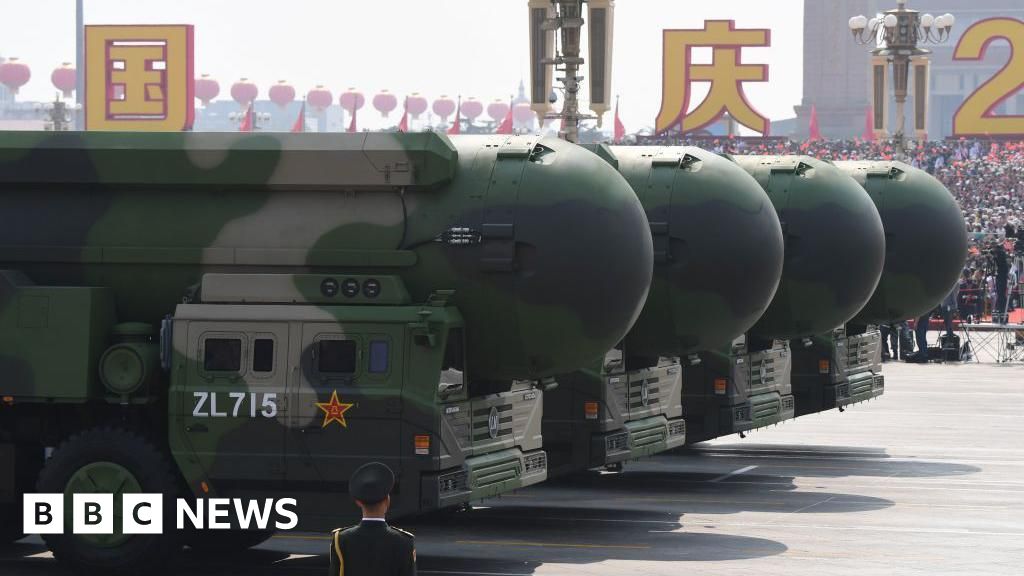
China test-fires ICBM for first time in decades
- International
- September 25, 2024
- No Comment
- 44
China has said it successfully launched an intercontinental ballistic missile (ICBM) carrying a dummy warhead into the Pacific Ocean.
The ICMB was launched at 08:44 local time (04:44 GMT) on Wednesday and “fell into expected sea areas”, Beijing’s defence ministry said, adding that the test launch was “routine” and part of its “annual training”.
The type of missile and its flight path remained unclear, but Chinese state media said Beijing had “informed the countries concerned in advance”.
Japan later said that it received “no notice” of the test launch.
China’s nuclear weapon tests usually take place domestically, and it previously test-fired ICBMs west into the Taklamakan Desert in the Xinjiang region.
This is believed to be the first time since 1980 that it launched an ICBM into international waters.
“Unless I’m missing something, I think this is essentially the first time this has happened – and been announced as such – in a long time,” Ankit Panda, a nuclear weapons specialist at the Carnegie Endowment for International Peace, wrote on X.
He added that Beijing’s description of the test as “routine” and “annual” was odd, “given that they don’t do this sort of thing either routinely or annually”.
The Japanese government said on Wednesday that China had given it no prior notice of the ICBM launch.
“There was no notice from the Chinese side in advance,” government spokesman Yoshimasa Hayashi told reporters.
Japan’s defence ministry had earlier said there was no damage to its vessels.
“We will continue to collect and analyse information on the movements of the Chinese military and will take all possible precautions in our vigilance and monitoring,” the ministry said early Wednesday afternoon, according to Japanese broadcaster NHK.
When China last did such a test – in May 1980 – the ICBM flew 9,070km and landed in the Pacific. That test involved 18 Chinese naval ships and is still considered one of China’s biggest naval missions.
“Timing is everything,” Drew Thompson, a visiting research fellow at the Lee Kuan Yew School of Public Policy in Singapore, wrote on X.
“[China’s] statement claims the launch does not target any country, but there are high-levels of tension between China and Japan, Philippines, and of course perpetual tension with Taiwan.”
“The launch is a powerful signal intended to intimidate everyone,” he added.
John Ridge, a US-based defence analyst, said China could have conducted the test as a form of “posturing or signalling to the United States”.
While the relationship between Beijing and Washington has improved in the past year, China’s increasing assertiveness in the region remains a sticking point.
Tensions have ramped up between China and the Philippines as their ships have repeatedly collided in disputed waters. Last month, Japan scrambled fighter jets after it accused a Chinese spy plane of breaching its air space, a move that it called “utterly unacceptable”.
Beijing’s claims over self-governed Taiwan have been another source of strain.
Taiwan’s defence ministry said earlier on Wednesday that China had been carrying out “intensive” missile firing and other drills recently. In the same statement, the ministry said it had detected 23 Chinese military aircraft operating around Taiwan on “long-range missions”.
Beijing routinely sends ships and aircraft into Taiwanese waters and airspace in what analysts say is a “greyzone warfare” tactic meant to normalise the incursions.
In July this year, China suspended its nuclear arms control talks with Washington, in retaliation for the US’ continued arms sales to Taiwan.
Last year, China replaced two leaders of the People’s Liberation Army’s Rocket Force unit – the elite unit managing its nuclear arsenal – over corruption allegations.
In a report published last year, the Pentagon estimated that China has more than 500 operational nuclear warheads in its arsenal, of which approximately 350 are ICBMs.
The report also projected that China will reach over 1,000 warheads by 2030. Still, that is a fraction of the more than 5,000 warheads that the US and Russia each say they possess.
#China #testfires #ICBM #time #decades









